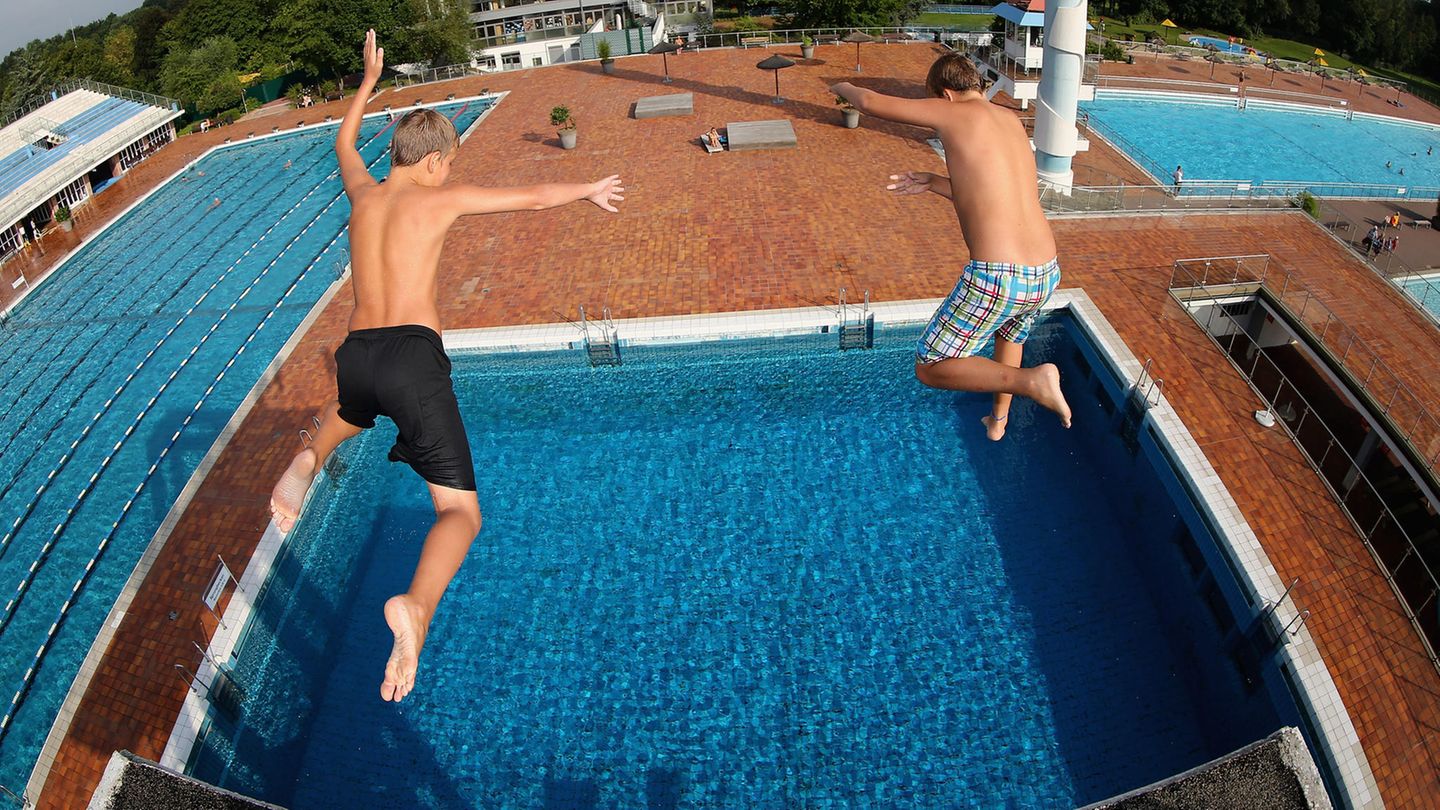Outdoor pool season
Jump from the ten-meter tower: what the danger is and how you jump safely
Copy the current link
Add to the memorial list
The diving tower belongs to the outdoor pool, like the roller coaster on the fun fair. But the larger the height, the more dangerous the water jump.
The ten-meter tower in the swimming pool is an absolute no-go for some, for others the jump is a test of courage or even the opportunity to profile yourself. The awe before the height is no coincidence, the jump from the tens is associated with a risk. Inexperiences in particular can contract serious injuries, which in the worst case will fatal.
What makes the jump from the ten-meter tower so dangerous? Which jump variant is the safest? And how can you prepare for such a jump? An overview of the most important points.
What happens to the body when jumping from the 10-meter tower?
Is only water? Are you kidding me? Are you serious when you say that! “The water is hard as concrete from this height,” says Joachim Rödig, chief physician of the Clinic for Orthopedics and Trauma Surgery at the Mönchengladbach Clinic Maria Hilf. In conversation with the “Rheinische Post” (RP), he warns: “An extreme force develops when jumping from a ten-meter tower.” If you get wrong to the water, you can pull severe injuries – “similar to a motorcycle accident”. Bones could break, the skin burst, and internal injuries and chest bruises are possible.
How often do injuries caused by jumps into the water from great height?
There are no numbers. However, statistics from the German Life Rescue Society (DLRG) show that in 2023 there were at least 378 bathing accidents with drowning death, another 23 more than in the previous year. Most cases (90 percent) occurred in internal waters – including in lakes (138) and rivers (135). The DLRG therefore warns against swimming in unusual waters. There were rarest deaths in swimming pools. In 2023 there were eight.
Who shouldn’t jump from the ten-meter tower?
Those who are experienced by jumping should not jump directly from the ten-meter tower. “To overestimate yourself is dangerous,” said Roland Scheidemann from the German Life Rettungs Society (DLRG) in an interview with the “RP”. Those who are unsure should be reasonable and climb back. Every jumper makes a ten-meter jump at his own responsibility. Even if supervisors could make sure that the pool is free and that there is only one on the tower, according to Scheidemann, it is still “life -threatening if someone tries a head jump that is not routinely”.
How do you best prepare for a jump from the tens?
Matti Büchner is head of water jumping at the Berlin TSC and trains the professionals as a federal base coach. The dpa asked him how best to start the first jump from the ten-meter tower. He recommends a slowly atmosphere-from the one-meter board to the three-meter board and so on. A strategy that is also used in competitive athletes and until they had enough body tension for a straight diving. He explains: “From a ten-meter tower, it is about 50 km/h with which you hit the water, there is a force.”
Which posture is the safest thing when jumping?
The safest way is the jump when it is carried out straight and with body tension: arms firmly on the body, legs closed, the toes stretched. This offers the least resistance to the water. Basically, however, a jump, no matter in which variant must be carried out cleanly in order to be as low as possible. A stomach or back gossip also hurts from the one-meter board.
How dangerous are other diving variants?
How hard water can be is noticeable from low heights – especially if you put a belly slap instead of an elegant head jump. An unfavorable landing on the water surface can quickly become painful. When jumping into the water, the smaller the body surface applies, the better. But what is most harmless? A tested which forces act on the body and what injuries can be expected when you first dive into the water with your head, hands or feet. For the experiment, dummies were made by 3D printing that were “shot” into the water. Sensors determined which forces worked in the impact. High -speed cameras documented the experiment.
The safest of the three jump variants? No surprise: the “candle”, the straight jump with your feet. According to the study, the risk of injuries only increases from a height of 15 meters if you choose this diving variant. It then becomes dangerous for the knees. If you want to avoid skin injuries, you should stretch your toes and not “open” with flat soles on the water surface. In the classic head jump, in which the palms are merged over the head, the risk of injuries increases from twelve meters. Accordingly, collarbone fractures are possible from this height. To avoid shoulder injuries, tense the arms and shoulders when immersing it. The most dangerous jumps are headed with the head, the arms laid out close to the body. The results of the researchers suggest that such a jump from eight meters can lead to considerable injuries. Accordingly, the neck and spinal cord could be dangerously affected. This is shown by comparisons with printing forces that are known that they cause bone and muscle läsions.
Does it make a difference whether you jump from the tower platform or a board?
A tower platform is firm, boards are flexible. This means that a lot of body tension in the middle of the body is required. Both the abdominal and back muscles should be tense when jumping from the board. Otherwise, it can happen that you “sack together”, which in turn can have a negative impact on the jump version- the jumper, for example, gets into the side or template.
Can you fly too far by starting and land on the edge of the pool?
A tens of jumping pool must be at least 13.5 meters wide from the edge of the diving tower. In order to skip this, the start -up speed should be 30 km/h. Nevertheless, the danger from height is great, especially if you lose body control and open on the water with an unfavorable body position. In addition, when you take it, you should always make sure that nobody is in the water you could jump on. Once in the air, the jump cannot be undone. It is best to give someone a sign when the water is free. Expert Büchner entirely advises against jumping from a jumping stone with a start -up. “They have a nasty anti-slip coating, so you can do a bit of a bit of a bit if you fall,” he explains. Instead, you should rather stand on the board at the front and jump on the spot in two or three times on the trampoline-with the appropriate body tension-before you jump into the water.
Why can some people jump from large heights without hurt themselves?
Technology! Whether professional tower jumpers or adventurous cliff jumpers, body tension is everything. This makes the body more compact. A trained immersion position is also important. The largest documented height from which a person has ever jumped is 58.8 meters. It was extreme athlete Laso Schaller who jumped from a waterfall in Ticino. When he immersed in the water, he had a speed of 123 km/h. Schaller ends up in foaming water, which was less hard than a smooth surface, but he still got an inner ligament tear.
How dangerous is the immersion after the jump?
A professional diving pool is five meters deep. A pelvis in the outdoor pool can be flatter. Expert Büchner therefore recommends checking the depth before jumping. With a pelvic depth of five meters, the body is usually slowed down enough when immersing it, and it recommends that it helps to help with lower water depth. The arms and legs spread out something from the body to increase the resistance. But be careful: first under water.
Source: Stern
I’m Caroline, a journalist and author for 24 Hours Worlds. I specialize in health-related news and stories, bringing real-world impact to readers across the globe. With my experience in journalism and writing in both print and online formats, I strive to provide reliable information that resonates with audiences from all walks of life.





